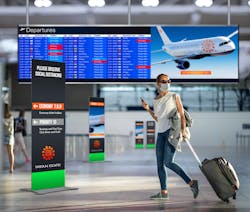How to Best Use Airport AV Communications to Handle the Holiday Rush

The holiday rush is always a challenging time for airport operations and travelers alike. The crush of travelers and infrequent flyers inside the terminal can create confusion and stress for everyone.
Clear communications with travelers are key to improving the passenger experience inside the terminal and AV communications technology is one of the most powerful tool airports have at their disposal to reach the traveling public.
Ben Hardy, senior product manager at Sharp NEC Display Solution offers these tips on how to best use this technology during the holiday season to improve airport operations and the passenger experience.
Install Displays Utilizing Commercial Grade, bright and Anti-Reflective Panels
Displays with high brightness are more accessible to the human eye and put less stress on the viewer. This means bright displays are easier to read regardless of ambient light conditions and ensure vital travel information can be seen and read at any time of day.
Equip Every Display with Backup Sources
During the busiest travel time of the year, a system failure can be a nightmare for airport personnel and travelers alike. IT teams need a quick and automatic changeover if a PC or media device goes down so that there will never be a blank screen and so that vital information is not lost. Setting a custom input detect functionality can also allow for the display to auto-return to the primary source once the sync returns.
Build COVID Reminders Into Your Digital Signage Content
Usually, displays in airports handle semi-static content through FIDS, BIDS or GIDS. Incorporating COVID-based messaging into these not only reminds travelers of the current rules that need to be followed but also changes up the content and refreshes the pixels to allow for longer overall life of product.
Ensure Proper Ventilation and Regular Cleaning of Digital Displays
Airports and train stations are open around the clock, which means that their digital signage displays run 24/7 and gather a lot of dust through regular usage. Dust and dirt build-up can potentially block natural ventilation, hurting the overall lifetime of the display. Ensuring that ventilation holes are wiped clear of dust and, if the display is being used in portrait, it is rotated correctly, could prolong the lifetime of the product and make sure that the displays remain running for extended periods of time as needed.
Make Sure to Lockout the Buttons and IR Receivers on Each Display
While oftentimes the physical displays in airports and other transportation hubs are out of reach, there are occasions when displays are at pedestrian level and could potentially be tampered with, taking away from the purposeful messaging that the displays were meant to show. This is why it is important to lock out the IR and button controls on the monitor to ensure that the only communication being delivered comes directly from the IT team via RS-232C or LAN. This is a necessary step to considerably lower risk.
About the Author
Joe Petrie
Editor & Chief
Joe Petrie is the Editorial Director for the Endeavor Aviation Group.
Joe has spent the past 20 years writing about the most cutting-edge topics related to transportation and policy in a variety of sectors with an emphasis on transportation issues for the past 15 years.
Contact: Joe Petrie
Editor & Chief | Airport Business
+1-920-568-8399
>> To download the AviationPros media kits, visit: Marketing Resource Center
>>Check out our aviation magazines: Ground Support Worldwide | Airport Business | Aircraft Maintenance Technology
